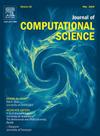AJAS: A high performance direct solver for advancing high precision astrometry
IF 3.1
3区 计算机科学
Q2 COMPUTER SCIENCE, INTERDISCIPLINARY APPLICATIONS
引用次数: 0
Abstract
In astrometry, the determination of three-dimensional positions and velocities of stars based on observations from a space telescope suffers from the uncertainty of random and systematic errors. The systematic errors are introduced by imperfections of the telescope’s optics and detectors as well as in the pointing accuracy of the satellite. The fine art of astrometry consists of heuristically finding the best possible calibration model that will account for and remove these systematic errors. Since this is a process based on trial and error, appropriate software is needed that is efficient enough to solve the system of astrometric equations and reveal the astrometric parameters of stars for the given calibration model within a reasonable time. This paper is an extended version of the conference paper published and discussed at the International Conference on Computational Science 2024. In this work, we propose a novel software architecture and corresponding prototype of a direct solver optimized for running on supercomputers. The main advantages expected from this direct method over an iterative one are the numerical robustness, accuracy of the method, and the explicit calculation of the variance–covariance matrix for the estimation of the accuracy and correlation of the unknown parameters. This solver can handle astrometric systems with billions of equations within several hours. To reach the desired performance, we use state-of-the-art libraries and methods for hybrid parallel and vectorized computing. The calibration model based on Legendre polynomials is tested by generating synthetic observations on grid-shaped constellation with specified distortions. For these small-sized test data, the solver can recover perfectly the correct physical solution under the condition that the correct amount of eigenvalues is zeroed out. During the space mission, the calibration model should be carefully fine-tuned according to the real operating conditions. The developed solver is furthermore tested using mock science data related to the Japan Astrometry Satellite Mission for Infrared Exploration. Up to 9.2 billion observations of 115 thousand stars can be processed in 8.5 h utilizing 5000 CPUs. A linear scaling with the number of CPUs and a quadratic scaling with the number of observations is demonstrated.
AJAS:用于推进高精度天体测量的高性能直接求解器
在天体测量学中,根据太空望远镜的观测结果确定恒星的三维位置和速度受到随机和系统误差的不确定性的影响。系统误差是由望远镜光学器件和探测器的缺陷以及卫星的指向精度引起的。天体测量学的艺术在于启发式地找到可能的最佳校准模型,以解释和消除这些系统误差。由于这是一个基于试验和错误的过程,因此需要适当的软件,它足够有效地解决天体测量方程系统,并在合理的时间内为给定的校准模型揭示恒星的天体测量参数。本文是在2024年国际计算科学会议上发表和讨论的会议论文的扩展版本。在这项工作中,我们提出了一种新的软件架构和相应的原型,优化了在超级计算机上运行的直接求解器。与迭代方法相比,这种直接方法的主要优点是数值鲁棒性,方法的准确性,以及用于估计未知参数的准确性和相关性的方差-协方差矩阵的显式计算。这个解算器可以在几个小时内处理数十亿个方程的天体测量系统。为了达到理想的性能,我们使用最先进的库和方法进行并行和矢量化混合计算。基于勒让德多项式的校正模型通过生成具有特定畸变的栅格星座的综合观测数据进行了验证。对于这些小尺寸的测试数据,求解器在剔除正确数量的特征值的情况下,可以很好地恢复出正确的物理解。在空间任务中,需要根据实际运行情况对标定模型进行细致的微调。利用与日本天体测量卫星红外探测任务相关的模拟科学数据进一步测试了所开发的求解器。利用5000个cpu,可以在8.5小时内处理多达92亿次对11.5万颗恒星的观测。证明了cpu数量的线性缩放和观测次数的二次缩放。
本文章由计算机程序翻译,如有差异,请以英文原文为准。
求助全文
约1分钟内获得全文
求助全文
来源期刊

Journal of Computational Science
COMPUTER SCIENCE, INTERDISCIPLINARY APPLICATIONS-COMPUTER SCIENCE, THEORY & METHODS
CiteScore
5.50
自引率
3.00%
发文量
227
审稿时长
41 days
期刊介绍:
Computational Science is a rapidly growing multi- and interdisciplinary field that uses advanced computing and data analysis to understand and solve complex problems. It has reached a level of predictive capability that now firmly complements the traditional pillars of experimentation and theory.
The recent advances in experimental techniques such as detectors, on-line sensor networks and high-resolution imaging techniques, have opened up new windows into physical and biological processes at many levels of detail. The resulting data explosion allows for detailed data driven modeling and simulation.
This new discipline in science combines computational thinking, modern computational methods, devices and collateral technologies to address problems far beyond the scope of traditional numerical methods.
Computational science typically unifies three distinct elements:
• Modeling, Algorithms and Simulations (e.g. numerical and non-numerical, discrete and continuous);
• Software developed to solve science (e.g., biological, physical, and social), engineering, medicine, and humanities problems;
• Computer and information science that develops and optimizes the advanced system hardware, software, networking, and data management components (e.g. problem solving environments).
 求助内容:
求助内容: 应助结果提醒方式:
应助结果提醒方式:


